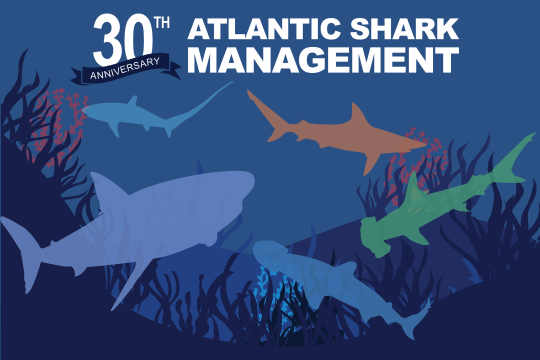Oceanic Whitetip Shark
Carcharhinus longimanus
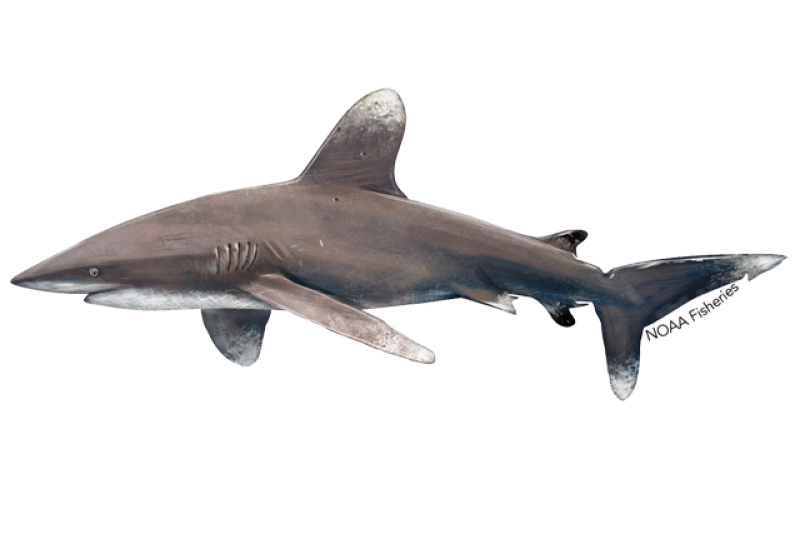
Protection Status
Quick Facts
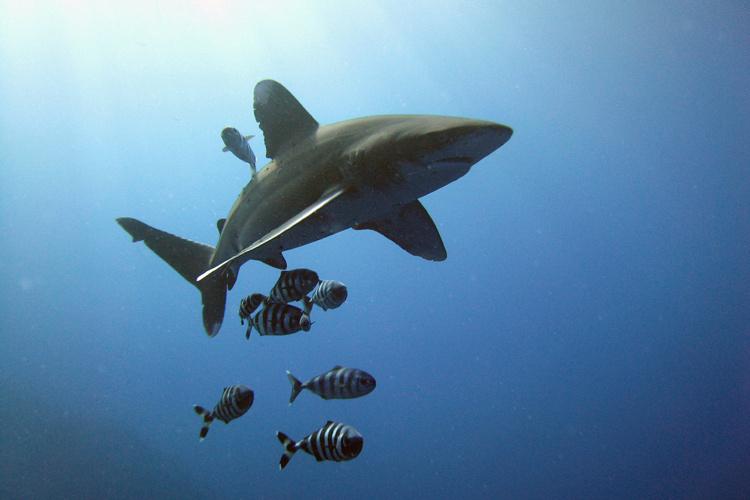 Oceanic whitetip shark. Credit: NOAA Fisheries
Oceanic whitetip shark. Credit: NOAA Fisheries
Oceanic whitetip shark. Credit: NOAA Fisheries
About the Species
 Oceanic whitetip shark. Credit: NOAA Fisheries
Oceanic whitetip shark. Credit: NOAA Fisheries
Oceanic whitetip shark. Credit: NOAA Fisheries
Oceanic whitetip sharks are large, pelagic sharks found in tropical and subtropical oceans throughout the world. They live offshore in deep water, but spend most of their time in the upper part of the water column near the surface. Oceanic whitetip sharks are long-lived, late maturing, and have low to moderate productivity.
The main threat to oceanic whitetip sharks is bycatch in commercial fisheries combined with demand for its fins. They are frequently caught in pelagic longline, purse seine, and gillnet fisheries worldwide and their fins are highly valued in the international trade for shark products. As a result, their populations have declined throughout its global range. In 2018, NOAA Fisheries listed the species as threatened under the Endangered Species Act.
Population Status
Information on the global population size of the oceanic whitetip is lacking. However, several lines of evidence suggest that the once common and abundant shark has experienced declines of potentially significant magnitude due to heavy fishing pressure. For example, the oceanic whitetip has declined by approximately 80 to 95 percent across the Pacific Ocean since the mid-1990s. Substantial abundance declines have also been estimated for the Atlantic Ocean, including an 88 percent decline in the Gulf of Mexico due to commercial fishing. Given their life history traits, particularly their late age of maturity and low reproductive output, oceanic whitetip sharks are inherently vulnerable to depletions, with low likelihood of recovery. Additional research is needed to better understand the population structure and global abundance of the oceanic whitetip shark.
Appearance
Oceanic whitetip sharks are large-bodied sharks with a stocky build, and have a distinctive pattern of mottled white markings on the tips of their dorsal, pectoral, and tail fins. These markings are why they are called “whitetip” sharks. Their dorsal fins are rounded and their pectoral fins are long and paddle-like. The color of their bodies varies depending on where they live. They are generally-grayish bronze to brown, while their undersides are whitish with some individuals having a yellow tinge.
Behavior and Diet
The oceanic whitetip shark are considered a top predator, eating at the top of the food chain. They are opportunistic, feeding primarily on bony fish and cephalopods, such as squid. However, they also reportedly feed on large pelagic sportfish (e.g., tuna, marlin), sea birds, other sharks and rays, marine mammals, and even garbage.
Where They Live
The oceanic whitetip shark is found throughout the world in tropical and sub-tropical waters. It is a pelagic species, generally found offshore in the open ocean, on the outer continental shelf, or around oceanic islands in deep water areas. Although they can make deep dives and have been recorded up to 1,082 meters (3,549 feet) deep, they typically live in the upper part of the water column, from the surface to at least 200 meters (656 feet deep). Oceanic whitetip sharks have a strong preference for the surface mixed layer in warm waters above 20°C, and are therefore considered a surface-dwelling shark.
Lifespan & Reproduction
Oceanic whitetip sharks are estimated to live up to 25 years, although it is thought that individuals may live to be much older (up to 36 years). Female oceanic whitetip sharks reach maturity between 6 and 9 years of age (depending on geographic location) and give birth to live young after a very lengthy gestation period of 10 to 12 months. The reproductive cycle is thought to be biennial, with sharks giving birth on alternate years to litters ranging from 1 to 14 pups (average of 6). There is also a likely correlation between female size and number of pups per litter, with larger sharks producing more offspring.
Threats
Commercial Fishing and Bycatch
The primary threat to the oceanic whitetip shark is incidental bycatch in commercial fisheries, including longlines, purse seines, and gillnets (among other gear types) Because of their preferred distribution in warm, tropical waters, and their tendency to remain at the surface, oceanic whitetip sharks have high encounter and mortality rates in fisheries throughout their range.
Harvest for international trade
Their large, distinct fins are also highly valued in the international shark fin trade.
Scientific Classification
| Kingdom | Animalia | Phylum | Chordata | Class | Chondrichthyes | Order | Carcharhiniformes | Family | Carcharhinidae | Genus | Carcharhinus | Species | longimanus |
|---|
Last updated by NOAA Fisheries on 08/30/2023
Featured News
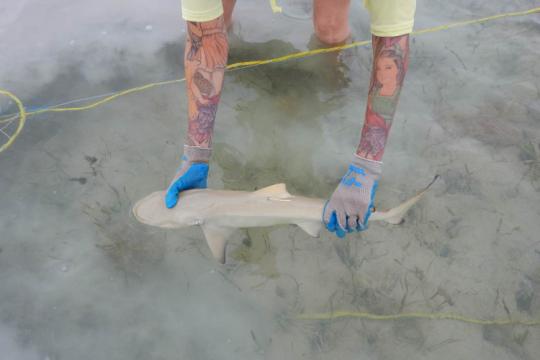 Previously tagged lemon shark Negaprion acutidens recaptured during survey
Previously tagged lemon shark Negaprion acutidens recaptured during survey
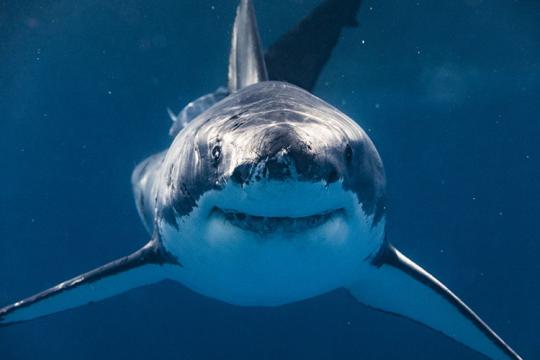
 The oceanic whitetip shark’s scientific name—Carcharhinus longimanus—comes from its long, rounded pectoral fin (Longimanus translates to “long hands”). Credit: Andy Mann
The oceanic whitetip shark’s scientific name—Carcharhinus longimanus—comes from its long, rounded pectoral fin (Longimanus translates to “long hands”). Credit: Andy Mann
In the Spotlight
Last updated by NOAA Fisheries on 08/30/2023
Management Overview
The oceanic whitetip shark is listed as threatened under the Endangered Species Act (ESA). It is also listed under Appendix II of the Convention on International Trade in Endangered Species of Wild Fauna and Flora (CITES), Annex III of the Protocol Concerning Specially Protected Areas and Wildlife of the Cartagena Convention (SPAW Protocol), and Annex I of the Sharks Memorandum of Understanding on the Convention on Migratory Species (CMS).
Recovery Planning and Implementation
Recovery Action
Under the ESA, NOAA Fisheries is required to develop and implement recovery plans for the conservation and survival of listed species. NOAA Fisheries has developed a recovery outline to serve as an interim guidance document to direct recovery efforts, including recovery planning, for the oceanic whitetip shark until a full recovery plan is developed and approved. The recovery outline presents a preliminary strategy for recovery of the species and recommends high priority actions to stabilize and recover the species.
Recovery Planning Workshops
We held two recovery planning workshops for the oceanic whitetip shark—one on April 23-24, 2019 in Honolulu, Hawaiߵi, and another on November 13 and 14, 2019 in Miami, Florida. The purpose of these workshops was to gather information, facts, and perspectives on how to recover the oceanic whitetip shark, including identifying potential recovery criteria and actions to address the threats to the oceanic whitetip shark. Participants included federal and state agencies, scientific experts, commercial fishermen, conservation partners, and non-governmental organizations.
- Recovery Planning Workshop Agenda - Honolulu, Hawaiߵi (PDF, 3 page)
- Recovery Planning Workshop Summary - Honolulu, Hawaiߵi (PDF, 18 pages)
- Recovery Planning Workshop Agenda - Miami, Florida (PDF, 3 pages)
- Recovery Planning Workshop Summary - Miami, Florida (PDF, 21 pages)
Draft Recovery Plan
Based on input provided at the recovery planning workshops and available data and scientific literature, we developed a Draft Recovery Plan in January 2023 (88 FR 4817). We are soliciting review and comment from the public and all interested parties on the Draft Recovery Plan, and will consider all substantive comments accepted through March 27, 2023, before submitting the Recovery Plan for final approval.
The Draft Recovery Plan follows the 3-part framework approach to recovery planning, in which recovery planning components are divided into three separate documents. The Draft Recovery Plan provides the foundation and overall road map for achieving the recovery goal. It contains the elements required to be in a recovery plan under the Endangered Species Act: (1) objective, measurable recovery criteria; (2) site-specific management actions necessary to conserve the species; and (3) estimates of the time and costs required to achieve the plan’s goals.
Draft Recovery Implementation Strategy
The Draft Recovery Implementation Strategy is a flexible, operational document that steps-down the recovery actions into more specifically defined activities that implement and support the recovery actions. The Recovery Implementation Strategy is intended to assist NOAA Fisheries and other stakeholders in planning and implementing activities to carry out the recovery actions in the recovery plan. The activities identified in the Recovery Implementation Strategy can be modified and adapted over time based on the progress of recovery and the availability of resources or new data or literature.
Recovery Status Review
Using the 2017 Status Review Report for the oceanic whitetip shark as a foundation, we developed an up-to-date Recovery Status Review for the species. A Recovery Status Review is a stand-alone document that provides all the detailed information on the species' biology, ecology, status and threats, and conservation efforts to date. This document was published in January 2023 and will be updated as necessary with new information. Traditionally, this information was included in the background of a recovery plan and became outdated quickly. As a stand-alone, living document, information can be kept more relevant.
Recovery Contacts
Kristen Koyama, Oceanic Whitetip Shark Recovery Coordinator
For more information on oceanic whitetip sharks in our regions:
Adam Brame, Southeast Region
Chelsey Young, Pacific Islands Region
Conservation Efforts
At the 2013 meeting of the Conference of the Parties to the Convention on International Trade in Endangered Species of Wild Fauna and Flora (CITES), the Parties agreed to include oceanic whitetip sharks in Appendix II of CITES, with the listing effective on September 14, 2014. The inclusion of oceanic whitetip sharks in CITES Appendix II helps ensure that the international trade for this species is legal and sustainable.
The U.S. Fish and Wildlife Service is the government agency designated under the Endangered Species Act to carry out the provisions of CITES. NOAA Fisheries provides guidance and scientific support on marine issues given our technical expertise.
Key Actions and Documents
Last updated by NOAA Fisheries on 08/30/2023
Last updated by NOAA Fisheries on 08/30/2023
Documents
Recovery Status Review for the Oceanic Whitetip Shark
Recovery Status Review for the Oceanic Whitetip Shark.
Draft Recovery Implementation Strategy for the Oceanic Whitetip Shark
Draft Recovery Implementation Strategy for the Oceanic Whitetip Shark (Carcharhinus longimanus).
Draft Recovery Plan for the Oceanic Whitetip Shark
The Draft Recovery Plan for the Oceanic Whitetip Shark includes the recovery goals, objectives,…
Biological Opinion on the Federally Regulated Oil and Gas Program Activities in the Gulf of Mexico
Programmatic biological opinion on the Gulf of Mexico oil and Gas Program in federal waters…
Data & Maps
American Samoa Longline Logbook Reports 2022
Logbook summary reports for the 2022 calendar year.
Hawaii and California Longline Logbook Reports 2022
Logbook summary reports for the 2022 calendar year.
Hawaii and California Longline Logbook Reports 2021
Logbook summary reports for the 2021 calendar year.
American Samoa Longline Logbook Reports 2021
Logbook summary reports for the 2021 calendar year.
Last updated by NOAA Fisheries on 08/30/2023
